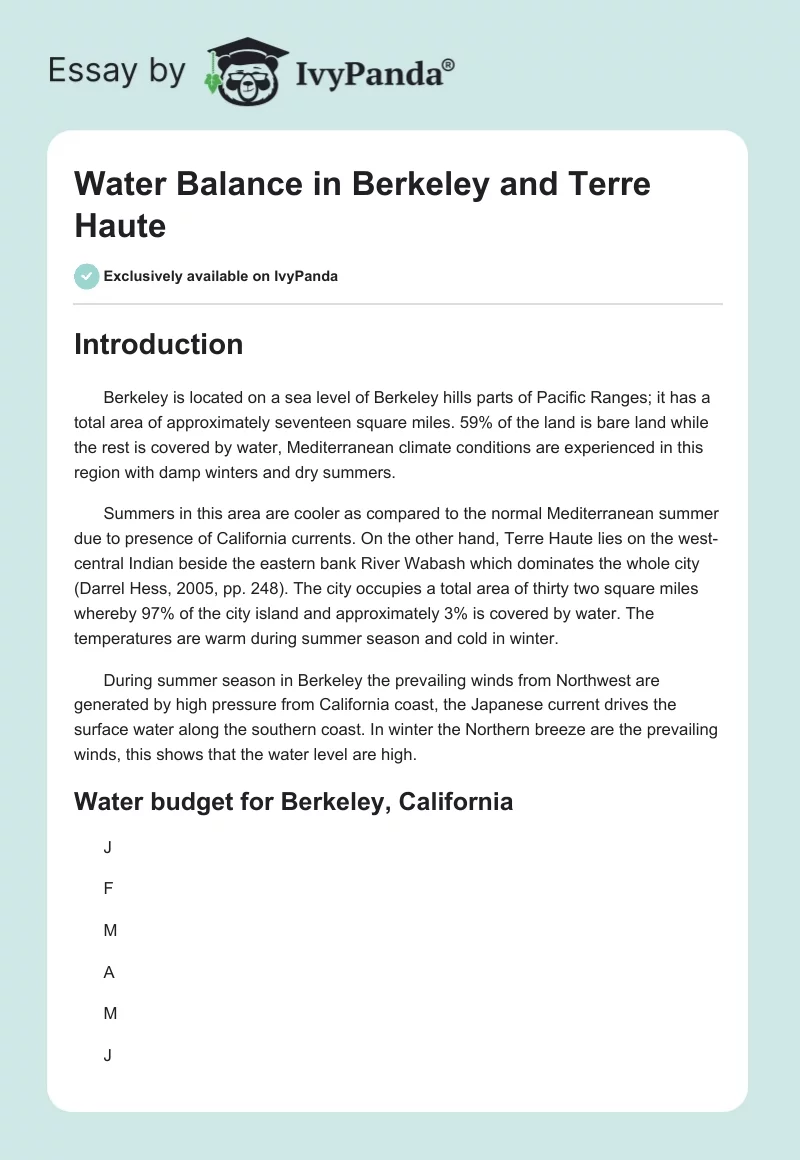Introduction
Berkeley is located on a sea level of Berkeley hills parts of Pacific Ranges; it has a total area of approximately seventeen square miles. 59% of the land is bare land while the rest is covered by water, Mediterranean climate conditions are experienced in this region with damp winters and dry summers.
Summers in this area are cooler as compared to the normal Mediterranean summer due to presence of California currents. On the other hand, Terre Haute lies on the west-central Indian beside the eastern bank River Wabash which dominates the whole city (Darrel Hess, 2005, pp. 248). The city occupies a total area of thirty two square miles whereby 97% of the city island and approximately 3% is covered by water. The temperatures are warm during summer season and cold in winter.
During summer season in Berkeley the prevailing winds from Northwest are generated by high pressure from California coast, the Japanese current drives the surface water along the southern coast. In winter the Northern breeze are the prevailing winds, this shows that the water level are high.
Water budget for Berkeley, California
Water Budget for Terre Haute, Indiana
Analyses of the charts
From the above charts Berkeley receives more precipitation compared to Terre Haute on the first three with the highest evaporation rate. From April to December Terre Haute receive the highest precipitation as compared to Berkeley.
Terre Haute rainfall is fairy distributed through out the year; May being the wettest month of the year. Between April and August Berkeley has low rainfall in the year with January being the wettest month on the year. Berkeley has high temperature compared to Terre Haute due to the presence of west coast Mediterranean climate. The actual evaporation is high in Berkeley as compared to Terre Haute as a result of high temperature and pressure in the region.
Berkeley has a high storage of water as compared to Terre Haute this is due it geographical location on coastal region with water bodies covering 41% of it land. A lot of vegetarian in the region has also contributed to the high water storage in the region. It’s clearly shown that Berkeley holds the highest amount of moisture between January and March which is brought about by a lot of vegetation in the region (Darrel Hess, 2005, pp. 342).
Terre Haute is on high altitude, the presence of mountains in the area blocks the wet winds from the ocean condense them to form relief rainfall in the region which leads to constant rain throughout the year. On the other hand, Berkeley being on the coastal plain humid winds result to convection rainfall in the region.
This occurs when water in the ocean is heated leading to evaporation of warm light air which rises and condenses on higher altitude to form convectional precipitation(Darrel Hess, 2005, pp. 185). These humid winds are strong from November all the way to March and hence contributing to the high precipitation. However, because of high pressure and temperature it has lead to the actual evaporation in the area.
The topography, prevailing winds, undergrowth and the soil in the region determines the water deficit in a region. Although Terre Haute receives constant rainfall through out the year it experiences water deficit between July and September. Terre Haute location on the hilly region explains why it not easy to store rain water for a long time leading to runoff.
This explains the presence of Wabash River in the region as the biggest river in the continent. California being on a coastal region it able to retain precipitation for a long period of time in spite of the high temperatures .From the chart above it also shows that the two regions have the same surplus of water due to less vegetation in the region (Darrel Hess, 2005, pp. 453).
Conclusion
In conclusion the climatic condition in the two areas determines the type of plants found, Terre Haute’s vegetation is adapted to cold winters and warm winter. This region has long evergreen vegetation with no underground plants while Berkeley has short ever green vegetation with a lot of underground plants. Berkeley city has high water storage as compared to Terre Haute due to it topography, elevation, prevailing winds and climate.
Reference
Darrel Hess, Tom L. McKnight. (2005). Physical Geography: A Landscape appreciation. Prentice Hall, pp. 559.


